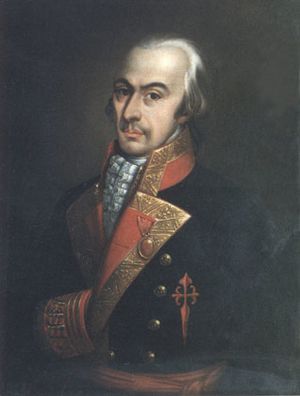José Antonio Pareja facts for kids
Quick facts for kids
Antonio Pareja
|
|
|---|---|
 |
|
| Captain General of Chile | |
| In office 1812–1813 |
|
| Monarch | Ferdinand VII |
| Preceded by | Francisco Antonio García Carrasco (As Royal Governor) |
| Succeeded by | Juan Francisco Sánchez |
| Personal details | |
| Born | 7 December 1757 Cabra, Spain |
| Died | 21 May 1813 (aged 55) Chillán, Chile |
| Children | José Manuel Pareja |
| Military service | |
| Allegiance | |
| Battles/wars | |
José Antonio de Pareja y Mariscal (born December 7, 1757, in Cabra, Spain – died May 21, 1813, in Chillán, Chile) was an important Spanish naval officer. He was a high-ranking officer called a Brigadier. He led the ship Argonauta during the famous Battle of Trafalgar in 1805. Later, in 1812, he commanded Spanish troops during the Chilean War of Independence.
Contents
Antonio Pareja's Life
Antonio Pareja was born in Cabra, a town near Córdoba, Spain. From a young age, he loved the Navy. He joined the Navy in 1771 as a midshipman, which is a junior officer. He sailed on many naval missions and took part in several battles.
He became known for successfully capturing the islands of St. Peter and St. Antiochus. From 1778 to 1782, he commanded different types of ships, including a frigate and a brig. Pareja fought against the British fleet in 1782. He also helped supply troops during battles, like the one at Melilla. His ships often brought artillery, ammunition, and food to soldiers.
In 1797, Pareja was the commander of the frigate Perla. He was involved in the naval Battle of Cape St Vincent. During another battle in the Bay of Algiers, a galley (a type of ship) under his command fired for eight hours.
Battle of Trafalgar
In 1803, Pareja commanded a ship called San Agustin. By 1805, he was given command of the Argonauta. This ship was part of a large fleet of French and Spanish ships. This combined fleet was led by Admiral Villeneuve and Lieutenant General Gravina.
On October 21, 1805, Pareja and his ship fought in the famous Battle of Trafalgar. This was a major naval battle against the English Admiral Lord Nelson. The Argonauta was badly damaged during the fight. It sank the day after the battle, causing many deaths and injuries, including to Pareja himself. Later that year, he was promoted to Brigadier.
In 1808, Pareja saw the French fleet surrender to the Spanish. After some time off, he returned to duty in 1809. He then commanded the ships Terrible and San Justo. In early 1810, he was in charge of all forces on the Isla de León.
Role in Chile
In July 1810, Pareja was appointed Governor and Captain-General of Chile. At this time, Chile was rebelling against Spanish rule. Pareja arrived in Lima in 1811. He was supposed to be the Governor of the Chilean province of Concepción.
However, plans changed. The Viceroy of Peru, José Fernando de Abascal, ordered Pareja to lead an expedition. This mission was to fight against Chiloé and Valdivia, which had declared their independence.
In February 1813, Pareja gathered about 2,400 soldiers. He captured the small port of San Vicente. From there, he marched to Concepción and took control of it. Local soldiers helped him, and his army grew to about 4,000 men. He then marched to Chillán, which surrendered without a fight. His army grew even larger, adding another 2,000 soldiers.
Meanwhile, Brigadier José Miguel Carrera was leading the independence movement in Santiago. The two armies met at the Battle of Yerbas Buenas on April 27, 1813. The independence fighters tried a surprise attack at night but had to retreat.
Pareja became very sick with pneumonia. He decided to retreat back to Chillán. He was so ill that he had to be carried on a stretcher. In Chillán, his forces faced a long siege. During this time, the port of Talcahuano was recaptured by the independence fighters. They also captured a ship bringing reinforcements from Callao. Pareja, already weak from his illness and upset by these losses, died soon after. Juan Francisco Sánchez took over command of the Spanish army.
Legacy
Antonio Pareja's son, Vice Admiral José Manuel Pareja, also became a famous naval officer. He commanded the Spanish fleet during the Chincha Islands War from 1864 to 1866.
See also
 In Spanish: Antonio Pareja para niños
In Spanish: Antonio Pareja para niños

